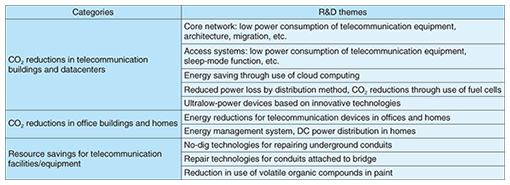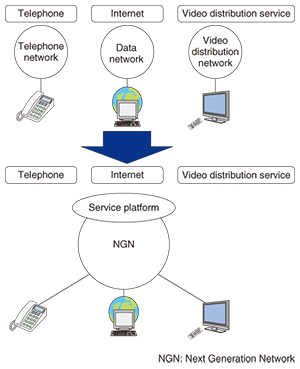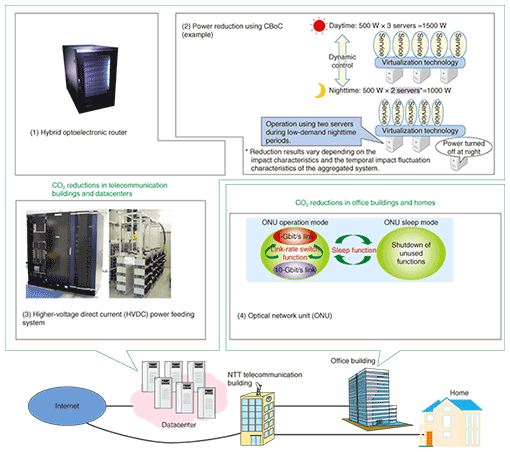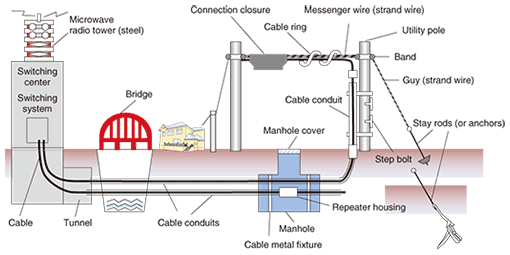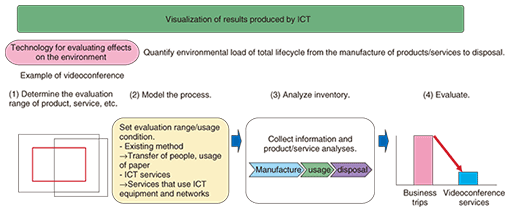 |
|||||||||||||||||||||||
|
|
|||||||||||||||||||||||
|
Feature Articles: New NTT Group Environmental Vision: Looking to 2020––THE GREEN VISION 2020 Vol. 9, No. 4, pp. 30–35, Apr. 2011. https://doi.org/10.53829/ntr201104fa4 Green R&D ActivitiesAbstractThis article describes NTT’s green research and development for reducing the environmental impact of society by reducing the impact of information and communications technology (ICT) installations in telecommunication centers, datacenters, and customers’ offices and homes (Green of ICT) and by reducing the impact in other sectors by providing various kinds of ICT services (Green by ICT).
1. IntroductionThe NTT Group seeks to reduce the environmental impact of society as a whole by reducing the environmental load of information and communications technology (ICT) platforms and changing lifestyles through the use of ICT. However, it is difficult to achieve this goal by using conventional technology. Therefore, we think that a breakthrough is needed. NTT seeks to provide ICT services that contribute to the resolution of global environmental issues. All of our research laboratories are engaging in green R&D. We have created four categories of ICT-related research and development (R&D) for contributing to reduced environmental impact. (1) Technology that contributes to reducing CO2 emissions in our telecommunication buildings and datacenters and by telecommunication equipment/facilities required for telecommunication service provision (2) Technology that contributes to reducing CO2 emissions from telecommunication devices in offices and homes (3) Technology that contributes to resource savings for telecommunication facilities/equipment (4) Technology that evaluates the environmental effect by quantifying CO2 reductions achieved by using ICT The collaboration of all research laboratories is essential to effectively and efficiently promote the abovementioned R&D. An overview of the R&D themes for CO2 reductions and resource savings technology categories is given in Table 1. We have also organized meetings for discussing strategies, policies, and tasks related to CO2 emissions and sharing information about these themes. Furthermore, to achieve the goals of THE GREEN VISION 2020 and realize further drastic CO2 reductions, we are conducting a plan-do-check-act (PDCA) cycle for each of the themes.
Moreover, to promote the procurement and development of ICT equipment that achieves further energy savings, all laboratories are actively participating in the establishment and revision of the NTT Group Energy Efficiency Guidelines that were established in April 2010. Specific actions are described below. 2. NTT’s Green R&D2.1 CO2 reductions in telecommunication buildings and datacentersThe configuration of telecommunication installations in NTT’s telecommunication buildings has changed rapidly along with the spreading use of the Internet. The change from the plain old telephony system to optical fiber has created high-speed broadband communication, which has helped to make a more convenient society. However, this change has also resulted in increased power consumption of telecommunication equipment and facilities. Therefore, NTT is working to develop technologies for achieving efficient usage and reducing the energy consumed by various network facilities and equipment owned by the NTT Group. Furthermore, we are cooperating with NTT Facilities in regards to air-conditioning technology that is expected to show significant power savings for telecommunication installations. In addition, to achieve effective ventilation control, we are conducting R&D to achieve energy savings in telecommunication installations that are linked with highly efficient air-conditioning systems. As part of our efforts to achieve low power consumption for all of the telecommunication networks, we are working to provide multiple services within a single network and reduce power consumption through network integration that efficiently uses network facilities (Fig. 1). We are also promoting R&D aimed at low power consumption for each individual network device. Particular attention is being given to the access networks, which account for more than half of the power consumed by the entire network. We are focusing on achieving low power consumption for network devices by integrating chips and reducing the number of components. Furthermore, we are conducting research on lower power consumption in future networks. One such research topic is hybrid optoelectronic router technology ((1) in Fig. 2), which enables a dramatic reduction in a router’s power consumption by minimizing optical-to-electrical and electrical-to-optical signal conversions while maintaining high-efficiency operation. This will become one of the foundations of future high-speed large-capacity telecommunications.
In the future, in response to forecasts of increased power consumption in datacenters, we will examine the energy saving effects of cloud computing technologies called CBoC (Common IT Bases over Cloud Computing (IT: information technology)) [1]. They aim to create a safe and secure open cloud that can be utilized for electronic government, core corporate functions, and other social infrastructures that require a high degree of reliability and public functionality. Furthermore, virtual operation management functions can be used to reduce the number of physical servers, aggregate operating servers, and perform dynamic control in accordance with traffic conditions. This will reduce power consumption by decreasing unnecessary server operations ((2) in Fig. 2). In addition to focusing on power consumption, we are also conducting R&D to increase the efficiency of the energy supply to equipment located within telecommunication buildings and datacenters. This research has resulted in the higher voltage direct current power (HVDC) feeding system [2] ((3) in Fig. 2), which was developed through cooperation with NTT Facilities. To handle the rising power consumption of ICT equipment, the conventional 48-V power supply system feeds an electrical current of several hundred amperes. As a result, there is a loss of current due to the resistance of the power cable (heat loss). Another problem is that the cable is heavy and hard to bend, which leads to poor workability. Even worse, it uses a lot of copper. Moreover, since installations such as existing datacenters use alternating current (AC) power supplies, there are many AC-DC and DC-AC conversions before the power reaches the ICT equipment. This also results in power losses. The HVDC power feeding system is effective for solving these problems. Using this technology, we have raised the power supply voltage to approximately 380 V and now supply power to ICT equipment by DC. This has enabled us to reduce the number of conversions and decrease the power loss. Furthermore, decreasing the electric current makes it possible to use thinner and lighter cables. This leads to decreased use of resources such as copper and plastic. As breakthrough technology for achieving the drastic CO2 reductions that will be required after 2020, we are actively researching fundamental technologies such as single-electron devices, nanoelectromechanical systems (NEMS), and silicon photonics. To examine the direction of future network architectures and elemental technologies, we plan to work toward Ultra Green ICT, which will achieve efficient and dramatic reductions in the amount of energy used. 2.2 CO2 reductions in office buildings & homesThe spread of the Internet has resulted in increased use of telecommunication devices in homes and offices. The amount of power consumed in homes accounts for approximately 14% (FY2008) [3] of domestic power consumption when classified by industrial field. Furthermore, the amount of home power consumption related to telecommunication devices has also increased. Telecommunication devices installed in customer offices and homes are used 24 hours a day, 7 days a week. Therefore, even a small reduction will lead to a large overall reduction. Focusing on this fact, NTT is conducting R&D for technology that will decrease power consumption associated with telecommunications in offices and homes. For example, we will develop advanced energy-saving technology for optical network units (ONUs) and low-power-consumption devices for broadband routers. In the case of ONUs, in addition to achieving lower power consumption for the equipment while it is operating, we are actively examining a sleep function that will shut down some ONU functions [4] when the amount of traffic is low and a link rate switch function that will change the speed of the link between the ONU and the optical line terminal located in the telecommunication building in accordance with the traffic volume ((4) in Fig. 2). 2.3 Resource savings for telecommunication facilitiesThe NTT Group owns a large number of facilities for providing communication services (Fig. 3). These facilities are renewed as necessary at the end of their useful lifespans or replaced in order to support new services. The facilities contain rare earths and scarce metals and use plastic derived from fossil fuels as well as base metals such as copper and iron.
NTT is conducting R&D to reduce the amount of resources used in telecommunication facilities and equipment. Our research focuses on extending the lifespans of current facilities, reducing the consumption of resources by increasing the density and compactness of facilities, and reducing the use of resources through new methods and technologies. For example, we are conducting R&D for technology to repair conduits used to lay cable underground and conduits for attaching cables to bridges. Moreover, in consideration of the environment, we are reducing the use of volatile organic compounds (VOCs) in paint utilized to prevent corrosion on various building structures. Other research topics include technology for evaluating quality [5]. 2.4 ICT-based visualization of environmental impact reduction resultsICT can increase the efficiency of manufacturing, consumer, and business activities, provide alternatives to physical movement and distribution, and alleviate traffic jams. It can also reduce power consumption and CO2 emissions while contributing to decreased environmental impact. As a method for quantitatively and objectively evaluating such results, we are currently studying and standardizing [6] the visualization of results produced by ICT, i.e., a technology for evaluating effects on the environment (Fig. 4).
One specific activity is the environmental label system for eco-friendly solutions [7], [8] that was established in 2009 (Fig. 5). This system evaluates the environmental effect of ICT solutions provided by the NTT Group. Solutions with results that exceed defined criteria are certified as environmentally friendly solutions. Through this system, we hope to provide customers and society with easy-to-understand information regarding services that are highly effective at reducing environmental impact.
References
|
|||||||||||||||||||||||








